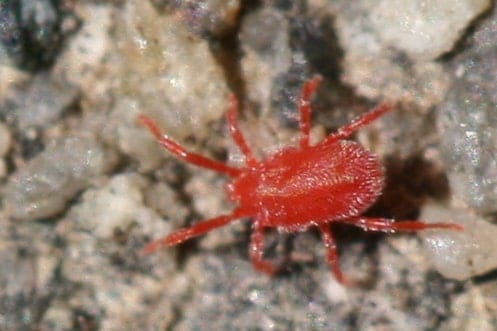Georgia’s warm and humid climate is not just inviting for humans, but also for various pests. Among them, clover mites stand out as a common nuisance for homeowners and sometimes business complexes. These tiny arachnids might be harmless to humans, but their presence can disrupt the aesthetic appeal of lawns, gardens, and structures. In this blog, we’ll delve into the world of clover mites in Georgia, exploring their habits, potential concerns, prevention methods, and management strategies.
Clover Mites: Tiny Red Bug Intruders
Clover mites are minuscule arachnids, measuring about 1/30th of an inch in length. They’re often mistaken for red spiders due to their color, but they are not true insects. Clover mites can also be black in color. The black variety will appear with the red mites. Clover mites are harmless to humans and pets, as they neither bite nor transmit diseases. However, their large numbers and tendency to gather in large clusters can create unsightly red stains on walls, sidewalks, and furniture when crushed.
Where Does A Clover Mite Live?
Clover mites like well-fertilized lawns, grassy areas, and landscapes with plenty of vegetation. They feed on plants, particularly clover, grass, and certain fruit trees. They are most active February through May. In the summer months they will lay eggs and may reemerge in October and November. During the cooler months, they might seek shelter inside homes and buildings through cracks, gaps, and crevices. Their activity typically peaks during the spring and fall when temperatures are moderate. They are most active in the spring and can invade a home quite easily.
Prevention Tips
Here are some effective prevention strategies to control this little red pest:
- Sealing Entry Points: Regularly inspect your home’s exterior for cracks, gaps, and openings that could serve as entry points for clover mites. Seal these areas with caulk or weather stripping.
- Landscape Management: Keep your lawn well-maintained by mowing it regularly and removing excess thatch. Trim back vegetation from the sides of your home to create a clear barrier.
- Trim Trees and Shrubs: Prune trees and shrubs that are in close proximity to your house. This reduces potential pathways for clover mites to access your home.
- Proper Watering: Avoid overwatering your lawn, as moist environments can attract clover mites. Water your lawn deeply but less frequently.
- Natural Predators: Encourage natural predators like ladybugs and spiders in your garden, as they can help keep clover mite populations in check.
Management Strategies
If you notice clover mites inside your home or office, it’s important to address the issue promptly to prevent their numbers from growing. Here are some effective management strategies:
- Avoid Crushing: When you encounter clover mites, avoid crushing them as they can leave red stains. Instead, gently vacuum them up or use a damp cloth to wipe them away.
- Soap and Water: A simple mixture of mild dish soap and water can be sprayed on clover mite clusters to eliminate them. This method is safe for plants and won’t harm beneficial insects.
- You can vacuum them up to avoid crushing them inside your home.
Pesticides: If infestations become severe, you can consider using pesticides specifically formulated for clover mites. Always follow the instructions on the label and use caution around plants, pets, and humans.
Professional Help: If the infestation persists despite your efforts, consider consulting a pest control professional with experience in treating clover mite infestations.
Just Remember
While clover mites might not pose a direct threat to humans, their presence can certainly be a nuisance. By understanding their habits, following prevention tips, and employing effective management strategies, you can maintain the beauty of your property and keep clover mite populations under control. Regular maintenance, attention to detail, and a proactive approach will go a long way in preventing and managing clover mite infestations in Georgia.




